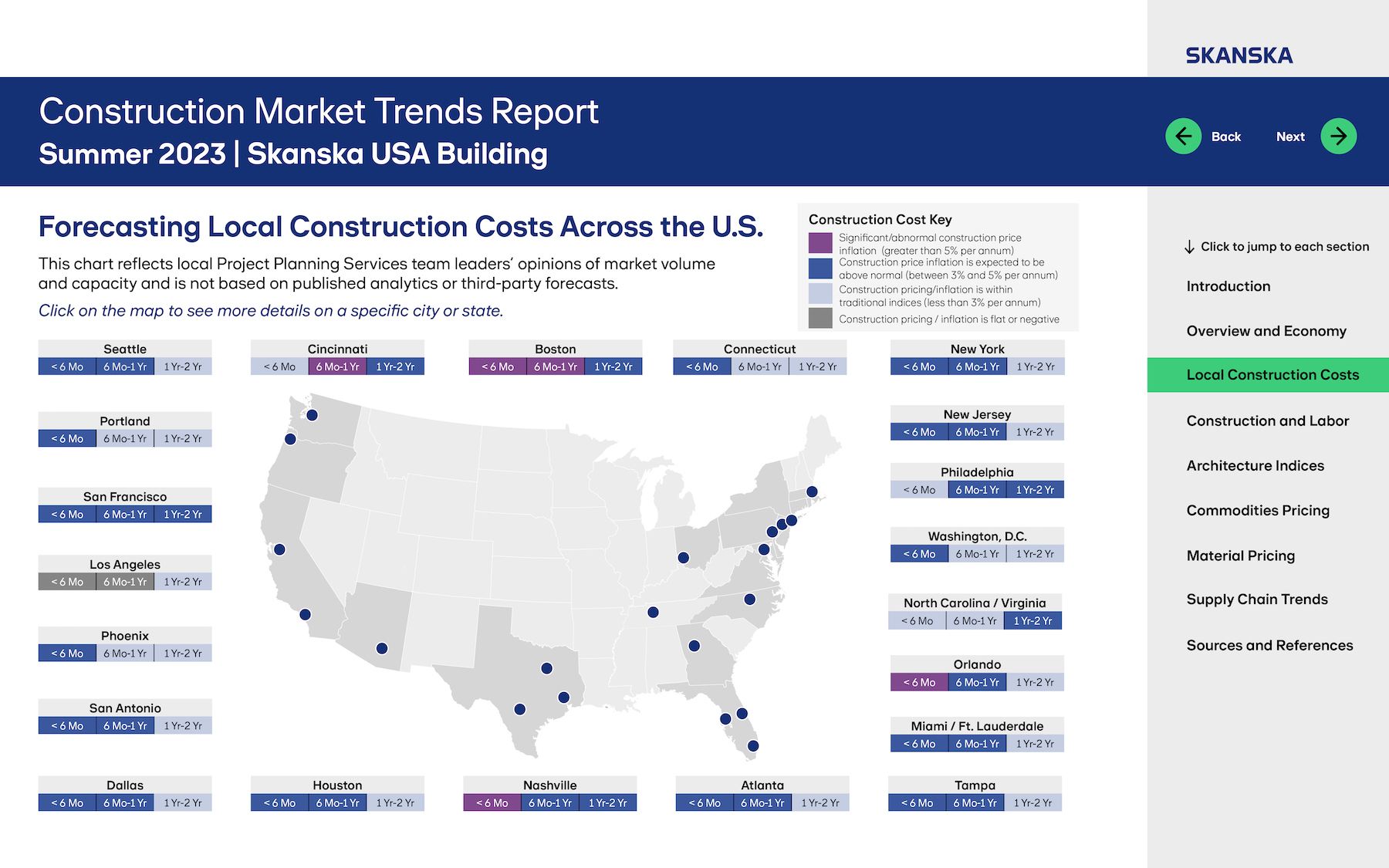While materials and labor price hikes continue to create havoc, they don’t seem to be shackling demand or activity for nonresidential construction, according to Skanska’s Summer 2023 Construction Market Trends Report, which looks at pricing and supply-chain trends for 14 product groups, and forecasts local construction costs for 21 markets across the U.S.
“Despite being the most expensive construction environment we have ever experienced … the health of the construction industry remains quite strong,” wrote Steve Stouthamer, Executive Vice President, Project Planning, Skanska USA Building, and one of the Skanska executives who produced this 43-page report. Stouthamer added that commercial office development and residential markets remain the most challenged by interest rate pressures, and offices are still contending with high vacancy rates.
Skanska anticipates significant or abnormal construction price inflation (greater than 5 percent per year) over the next six to 12 months in Nashville, Boston, Cincinnati, and Orlando. Indeed, with the exception of Los Angeles and the North Carolina/Virginia region, the other markets that Skanksa’s report tracks are expected to experience at least above-normal (3-5% per annum) construction price inflation over the next six to 24 months.
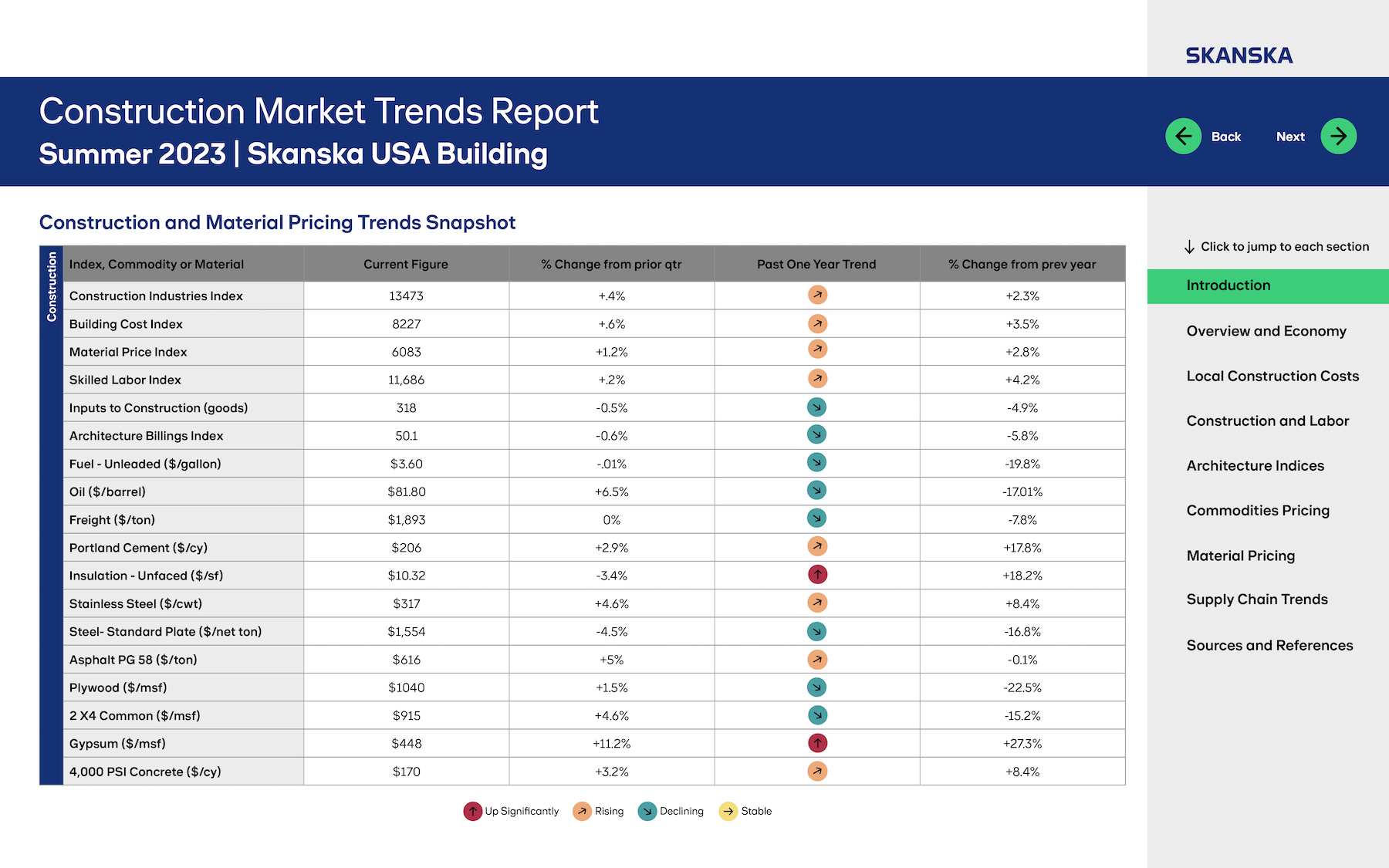
Different sectors driving local economies
Skanska evaluated business conditions and prospects for each of the markets it tracked.
Take Seattle, for example: New labor agreements, coupled with manpower shortages and the availability of materials and equipment, are pushing construction prices up. But much-needed tourism is returning there, re-energizing the retail, hospitality, and aviation sectors. And outside of the downtown core, Skanska saw “plenty of opportunities for new projects,” notably in K-12, mass transit, and aviation.
In Philadelphia, the same inflation dynamic exists. But that hasn’t stopped Philly’s healthcare sector from gaining momentum, and life sciences continues to be vibrant, “with new capital projects and office as clients realize the importance of new amenity space to bring staff back to work.” Skanska also foresees a laggard Higher Ed sector in recovery, with several new projects under consideration for this year and next.
Skanska’s report cited the Architecture Billings Index in June as another barometer of construction demand, and the news was mixed. While business conditions have improved for architecture firms in all regions except the West, the pace of growth inquiries since March has slowed, and the value of new design contracts has declined.
An uncertain stability for construction costs
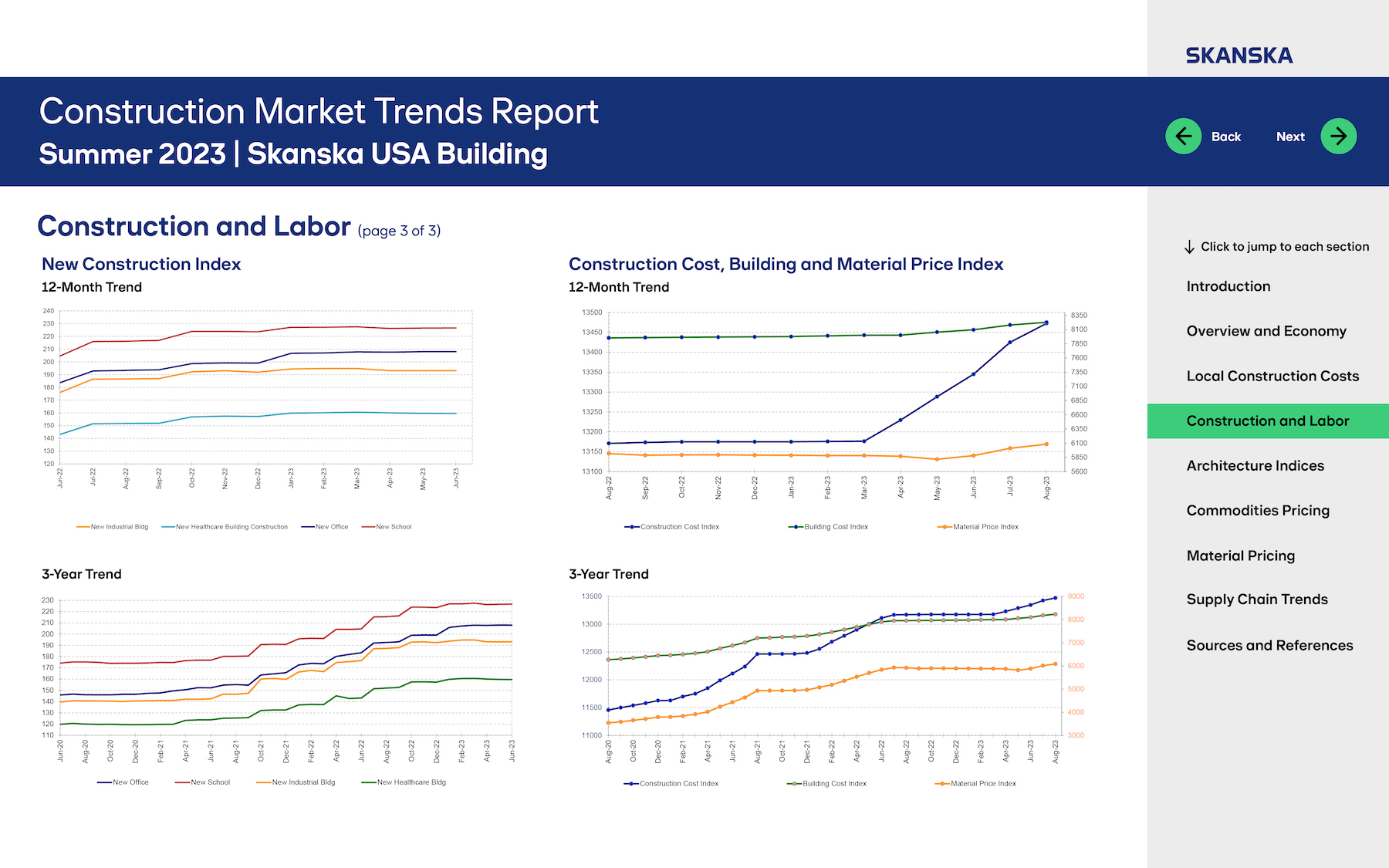
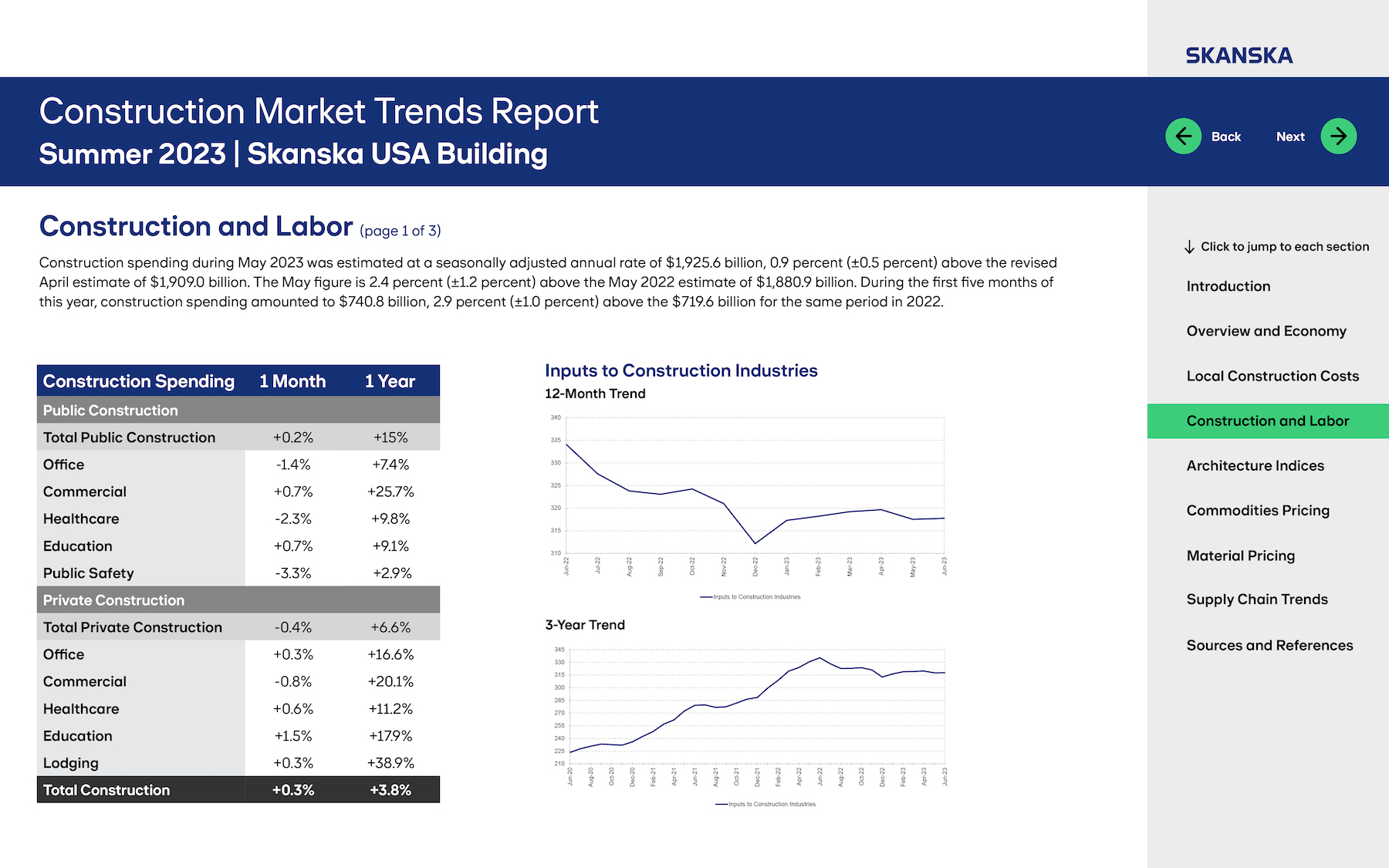

Every metro market tracked in Skanska’s report has had to cope with rising costs for materials and labor, which Skanska estimates rose nationally by 4.2% and 2.8% respectively, compared to the same period a year ago. But only two product categories—unfaced insulation and 4,000-psi gypsum—were up significantly: by 18.2% and 27.3%, respectively. Conversely, the costs of three product groups tracked–-standard plate steel, plywood, and 2x4s—were trending downward. Skanska also reported declines in the cost of fuel, oil, and freight, though the firm expected fuel costs to remain “elevated” through the rest of this year.
Softness in asphalt pricing is tied to lower seasonal demand, and Skanska expects prices for this material to increase again based on infrastructure work. Cement and concrete prices continued to improve early this year, but could increase dramatically as the weather got warmer. The pricing for structural steel has also stabilized, but Skanska expects a slight uptick in the future. Pricing for aluminum and copper, despite moderate declines, remain high compared to historical levels, as demand is strong.
As for product availability, Skanska said that over the previous quarter, the construction supply chain has continued to improve, “most notably around raw material prices for PVC resins, steel, copper, and lumber.” The supply chain for roofing products “has fully recovered.” Inventory for plumbing and fixtures appears to be healthy.
The challenges lie with HVAC and electrical gear availability. though several HVAC equipment manufacturers have reported improvements in their backlogs of orders due to increased factory capacity. (The one glaring exception is chillers that still have lead times of between 45 and 65 weeks.)
Skanska predicted that the construction industry’s lean toward electrification, as well as investment in data centers, will likely last for several more years. Investment in production capacity for electrical equipment products should allow manufacturers to be able to keep up with “persistent demand.”
Regional takes on construction costs
Looking at market conditions from a slightly narrower perspective, Mortenson’s just-released nonresidential Construction Cost Index, which tracks quarterly spending and inflation trends in seven markets—Seattle, Portland, Denver, Phoenix, Milwaukee, Chicago, and Minneapolis—stood at 182 nationally in the second quarter of 2023, or 8.72% higher than for all of 2021. Within that time frame, Phoenix saw the biggest increase in its index (12.22% to 187.3), and Portland the smallest (6.06% to 187.4).
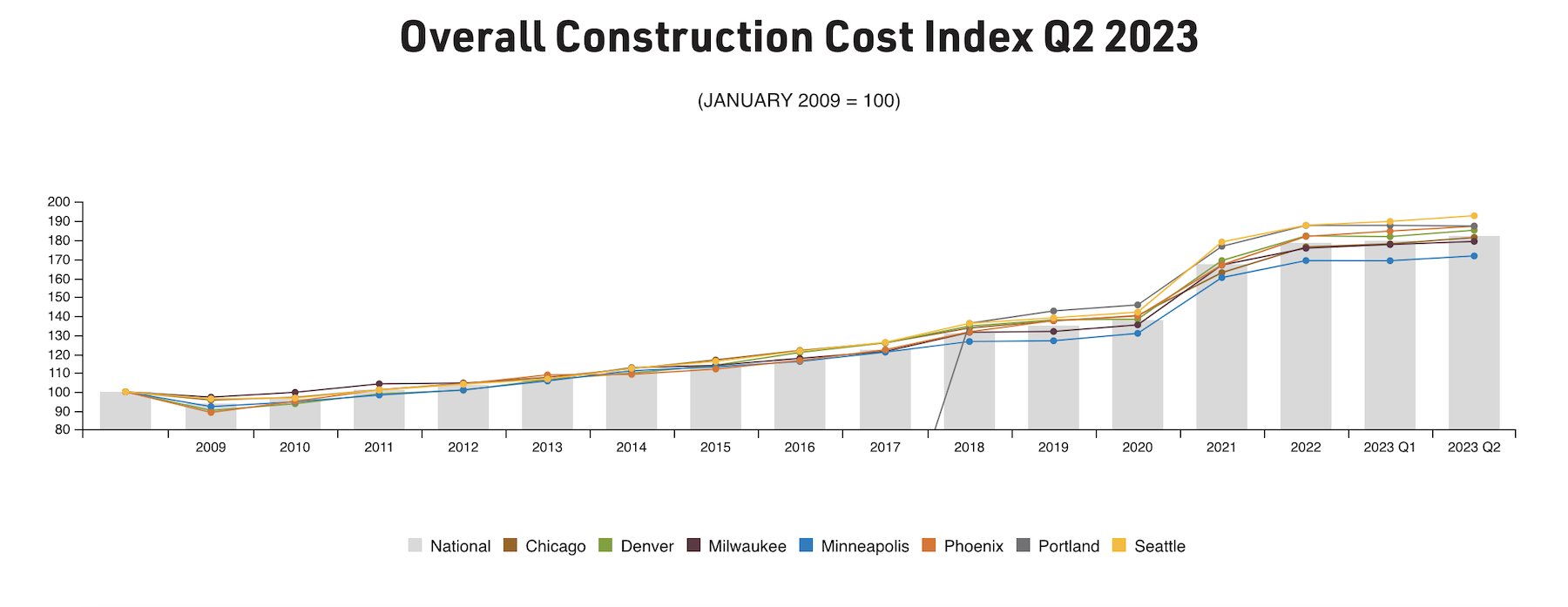
“Our construction cost index shows a continued flattening of material costs, suggesting pandemic, supply-chain, and inflation-related increases experienced over the last two years have largely abated,” states Mortenson. Nationally, nonresidential construction costs during Q223 increased year over year by 2.94%. Mortenson’s overall outlook for nonresidential construction remains optimistic but also cautious, primarily because increasing labor costs “are beginning to offset the stabilization.”
Data from Gordian’s RSMeans City Cost Index illustrates how dramatically costs differ by region, and how doing business in coastal markets is more expensive.
The City Cost Index takes into account the costs of labor, materials, and equipment, and compares that aggregate number to a national average of 30 major U.S. cities. The cost model encompasses 66 materials, 21 trades, and six pieces of equipment (plus fuel and maintenance costs).
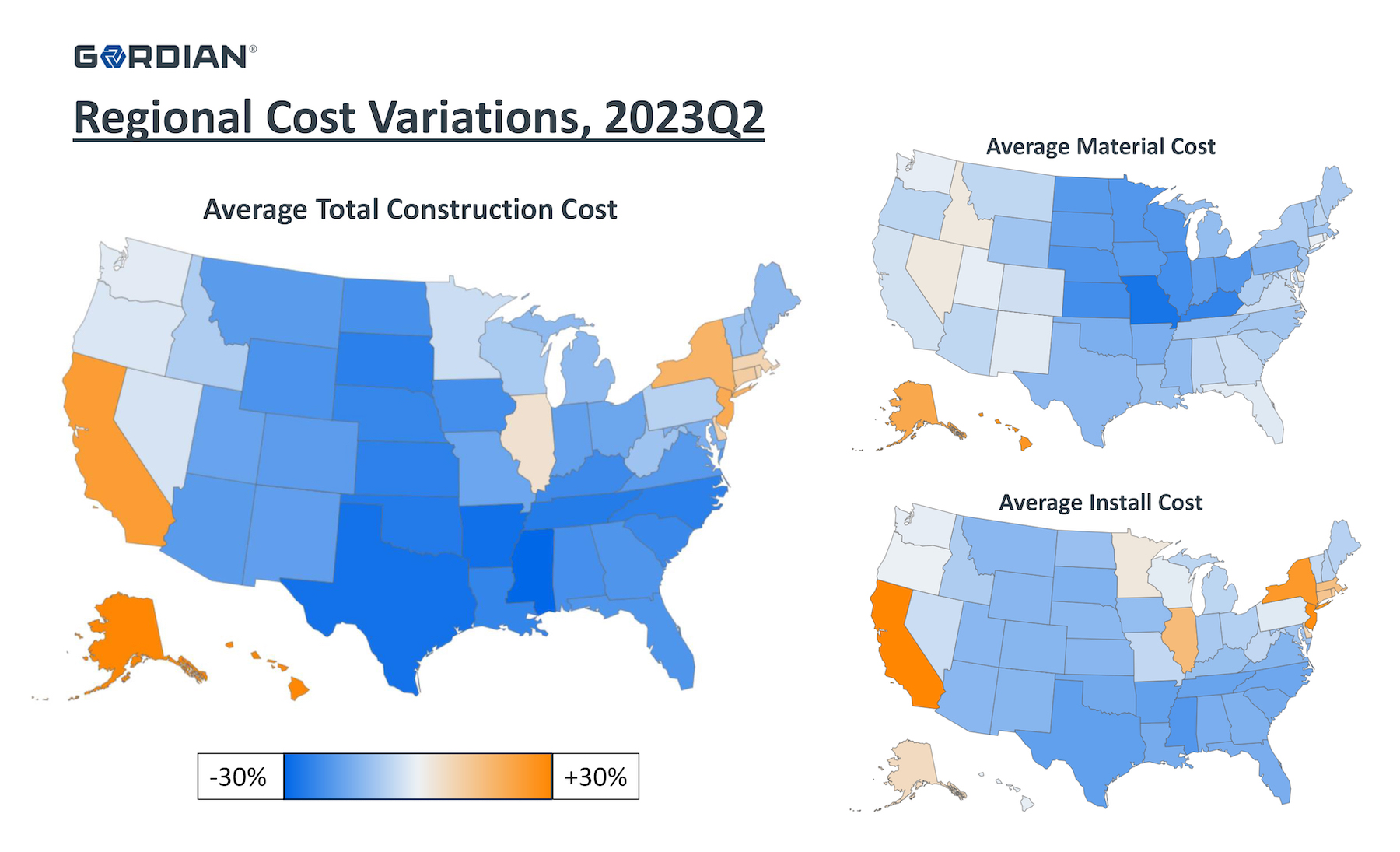
The map above illustrates regional cost differences during the second quarter of 2023. Here are some takeaways:
•The average costs of construction are highest across California, Hawaii, and Alaska; and lowest across Mississippi;
•Materials costs are highest as you move farther east and west from the Mississippi River;
•Costs for installation (labor and equipment) are highest in the West and Northeast.
Related Stories
Office Buildings | Feb 9, 2023
Post-Covid Manhattan office market rebound gaining momentum
Office workers in Manhattan continue to return to their workplaces in sufficient numbers for many of their employers to maintain or expand their footprint in the city, according to a survey of more than 140 major Manhattan office employers conducted in January by The Partnership for New York City.
Giants 400 | Feb 9, 2023
New Giants 400 download: Get the complete at-a-glance 2022 Giants 400 rankings in Excel
See how your architecture, engineering, or construction firm stacks up against the nation's AEC Giants. For more than 45 years, the editors of Building Design+Construction have surveyed the largest AEC firms in the U.S./Canada to create the annual Giants 400 report. This year, a record 519 firms participated in the Giants 400 report. The final report includes 137 rankings across 25 building sectors and specialty categories.
Multifamily Housing | Feb 7, 2023
Multifamily housing rents flat in January, developers remain optimistic
Multifamily rents were flat in January 2023 as a strong jobs report indicated that fears of a significant economic recession may be overblown. U.S. asking rents averaged $1,701, unchanged from the prior month, according to the latest Yardi Matrix National Multifamily Report.
Market Data | Feb 6, 2023
Nonresidential construction spending dips 0.5% in December 2022
National nonresidential construction spending decreased by 0.5% in December, according to an Associated Builders and Contractors analysis of data published today by the U.S. Census Bureau. On a seasonally adjusted annualized basis, nonresidential spending totaled $943.5 billion for the month.
Architects | Jan 23, 2023
PSMJ report: The fed’s wrecking ball is hitting the private construction sector
Inflation may be starting to show some signs of cooling, but the Fed isn’t backing down anytime soon and the impact is becoming more noticeable in the architecture, engineering, and construction (A/E/C) space. The overall A/E/C outlook continues a downward trend and this is driven largely by the freefall happening in key private-sector markets.
Hotel Facilities | Jan 23, 2023
U.S. hotel construction pipeline up 14% to close out 2022
At the end of 2022’s fourth quarter, the U.S. construction pipeline was up 14% by projects and 12% by rooms year-over-year, according to Lodging Econometrics.
Products and Materials | Jan 18, 2023
Is inflation easing? Construction input prices drop 2.7% in December 2022
Softwood lumber and steel mill products saw the biggest decline among building construction materials, according to the latest U.S. Bureau of Labor Statistics’ Producer Price Index.
Market Data | Jan 10, 2023
Construction backlogs at highest level since Q2 2019, says ABC
Associated Builders and Contractors reports today that its Construction Backlog Indicator remained unchanged at 9.2 months in December 2022, according to an ABC member survey conducted Dec. 20, 2022, to Jan. 5, 2023. The reading is one month higher than in December 2021.
Market Data | Jan 6, 2023
Nonresidential construction spending rises in November 2022
Spending on nonresidential construction work in the U.S. was up 0.9% in November versus the previous month, and 11.8% versus the previous year, according to the U.S. Census Bureau.
Industry Research | Dec 28, 2022
Following a strong year, design and construction firms view 2023 cautiously
The economy and inflation are the biggest concerns for U.S. architecture, construction, and engineering firms in 2023, according to a recent survey of AEC professionals by the editors of Building Design+Construction.


